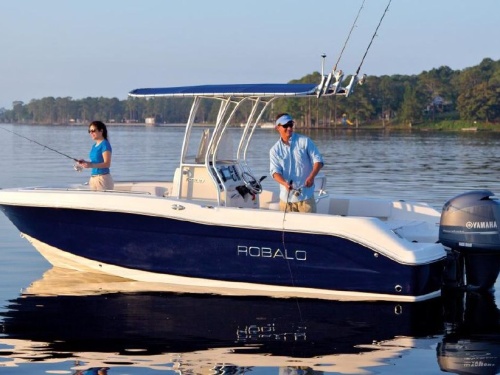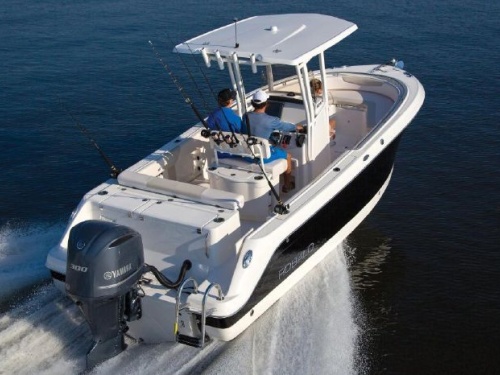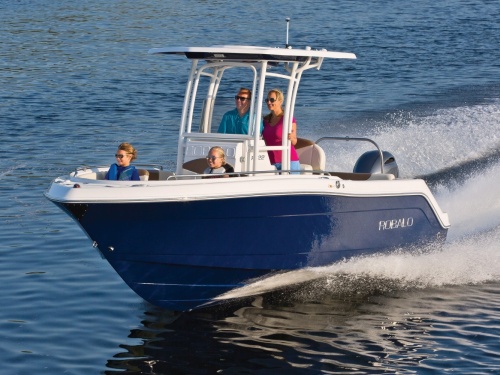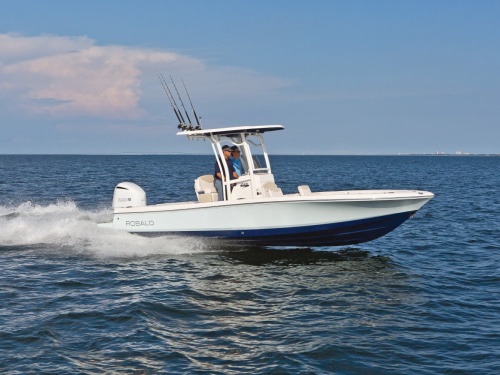Access More Boat Tests
Already have an account? Login
Robalo R222 (2019-)
1 x 200-hp Yamaha F200xp
Price
See the price by becoming
a BoatTEST member.
Members Must Log In
Brief Summary
Robalo is throwing its gauntlet down in front of builders of center consoles with its new-for-2014 R222. She is the largest boat in the Robalo fleet with a nationally advertised price -- $39,765 with a Yamaha F150XA outboard, sans trailer. She has a front-opening head compartment, 15 gallon livewell in the leaning post, two 30-gallon fish boxes, and a clever foldaway transom seat that lifts up to access the electrical system and pumps. Like all Robalos, she has decent bow flare and a relatively high freeboard, which we like.
Key Features
- Imedge premium gel coat
- 2 30 gal. fish boxes with overboard drains
- 15 gal. livewell with LED lighting
- Storage bins and beverage holders
- Aft folding seat with backrest
- Sound system with 4 speaker AM/FM CD player, remote, and MP3 plug
- 3-step telescoping boarding ladder with handle
- Porta-Potti
Test Results
| RPM | MPH | Knots | GPH | MPG | NMPG | STAT. MILE | NM | dBa |
|---|---|---|---|---|---|---|---|---|
| 600 | 1.4 | 1.2 | 0.35 | 4 | 3.48 | 324 | 282 | 63 |
| 1000 | 4.8 | 4.2 | 0.7 | 6.86 | 5.96 | 555 | 483 | 61 |
| 1500 | 6.5 | 5.7 | 1.25 | 5.2 | 4.52 | 421 | 366 | 71 |
| 2000 | 7.6 | 6.6 | 1.95 | 3.87 | 3.37 | 314 | 273 | 80 |
| 2500 | 8.4 | 7.3 | 3.4 | 2.47 | 2.15 | 200 | 174 | 79 |
| 3000 | 12.1 | 10.5 | 4.6 | 2.63 | 2.29 | 213 | 185 | 79 |
| 3500 | 20.3 | 17.7 | 6.2 | 3.27 | 2.85 | 265 | 231 | 88 |
| 4000 | 26 | 22.6 | 7.6 | 3.42 | 2.97 | 277 | 241 | 85 |
| 4500 | 30.2 | 26.2 | 9.5 | 3.17 | 2.76 | 257 | 224 | 89 |
| 5000 | 34.4 | 29.9 | 13.75 | 2.5 | 2.17 | 202 | 176 | 90 |
| 5500 | 38 | 33 | 16.85 | 2.26 | 1.96 | 183 | 159 | 92 |
| 5800 | 42 | 36.5 | 19.45 | 2.16 | 1.88 | 175 | 175 | 95 |
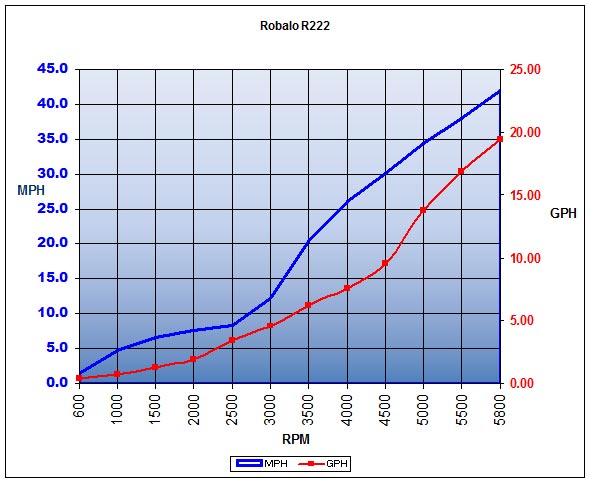
Specifications
| Length Overall | 21' 6'' / 6.55 m |
|---|---|
| Beam |
8' 6'' 2.59 m |
| Dry Weight |
3,200 lbs. 1,452 kg |
| Tested Weight |
3,890 lbs. 1,764 kg |
| Draft |
34'' 86 cm |
| Deadrise/Transom | 21-deg. |
| Max Headroom |
5' 5'' 1.65 m (console) |
| Bridge Clearance |
8' 2'' 2.49 m |
| Fuel Capacity |
90 gal. 341 L |
| Water Capacity |
9 gal. 34 L |
| Total Weight |
3,890 lbs. 1,764 kg |
Acceleration Times & Conditions
| Time to Plane | 3.3 sec. |
|---|---|
| 0 to 30 | 10.1 sec. |
| Ratio | N/A |
| Props | 14.5x15p reliance 3 blade |
| Load | 2 persons, 1/2 fuel, no water, 50 lbs of gear |
| Climate | 92 deg., 89 humid.; wind: 10-15 mph; seas: calm |
Engine Options
| Tested Engine |
1 x 200-hp Yamaha F200xp |
|---|---|
| Std. Power |
N/A |
| Opt. Power |
1 x 150-hp Yamaha 4-stroke F150XA 1 x 200-hp Yamaha 4-stroke F200XB 1 x 200-hp Yamaha 4-stroke F200XCA 1 x 250-hp Yamaha 4-stroke F250XA 1 x 250-hp Yamaha 4.2L V6 4-stroke |
Warranty
| Hull Warranty Extended | 10 year limited |
|---|
 Learn More
Learn More
Watch Our Video
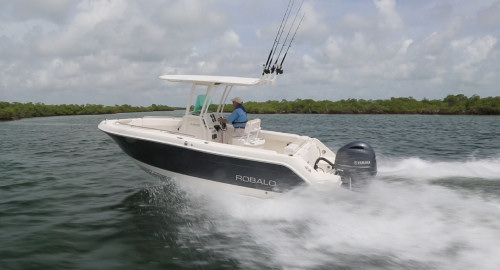
Mission of the New Robalo R222
With the new R222, Robalo set out to build a boat that has virtually all of the features of a premium offshore center console for something near half the cost.
The R222 is the largest boat in the Robalo line that has a "nationally advertised " price -- which means that consumers can walk into any Robalo dealer and get the boat for this price, plus shipping and dealer prep. Powered with a Yamaha F150 4-stroke outboard and without a trailer, that price is $40,795.
Is it mission impossible? Our report will allow consumers to judge for themselves.
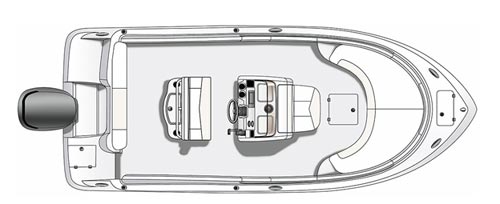
Distinguishing Features
For this report we will divide the boat's features into two groups: 1) "Distinguishing Features", and 2) "Major Features". The difference between the two is that "Distinguishing Features" are ones that most boats in class do not have as standard equipment, or at all. "Major Features" are ones we deem noteworthy on this or any boat in class and many boats have them either as standard or optional equipment. Aspects of the boat that are in common with virtually all boats in class are taken for granted and may not be mentioned at all.
Forward Head Access. The R222 is one of the first boats in class and one of the few center consoles at any price point that has a head accessed by swinging away the forward console seat. This design has many advantages which will be discussed below.
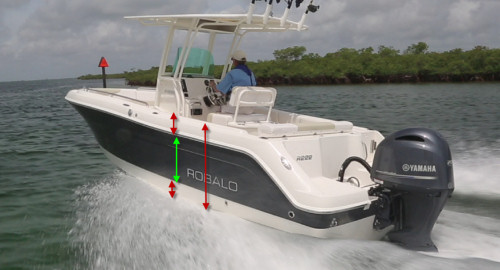
High Freeboard and Deep Cockpit. The R222 was intended for offshore work and the higher the freeboard the better, particularly forward, in order to keep the boat dry and safe. The advantages of a deeper cockpit are obvious. High freeboards add weight and cost to the boat and if not properly handled can be ugly. We think Robalo has done a good of creating the best of both worlds on this important aspect of the R222.
Kevlar Keel Lamination. A strip of Kevlar is placed into the fiberglass lamination at the keel of the boat to protect against hard groundings or high-speed contact with a floating object. Few center consoles have this feature at any price point.
21-Degree Deadrise. When we look at all center consoles in this size range we see that most builders hedge their bets between speed and comfort. At 21-degrees the R222 has one of the deepest deadrises of any boat in class. That should give her a superior ride offshore, and possibly a slight penalty in speed.
The Price. Given the amenities on board as standard equipment, and the overall design, we would say the price sets the R222 apart from boats costing far more that are essentially the same, or that are a few hundred pounds heavier.
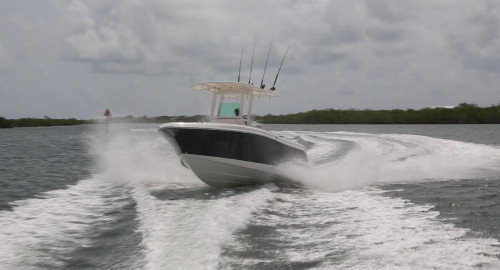
Comparison to Other Boats
Price-Point Boats. When we compare the basic specs of the R222 to other boats in her price range we discover that her weight is about the same as some others, but heavier than many -- as much as 430 lbs. (204 kgs.) more than some price-point boats. Although there are a couple of boats with less than an 8'6" beam, most are the same.
Premium-Priced Boats. When we compare the R222 with more expensive center consoles we find that she is about the same weight as some but from 100 lbs. to 700 lbs. (45 to 318 kgs.) lighter than some well-known names.
Other Parameters. The R222 seems to draw more water at 18" (45 cm) than most of the boats we studied, probably as a result of the combination of her weight and her deadrise at the transom. As noted above, at 21-degrees the R222's deadrise is greater than most other boats in class no matter what the price. Most other boats are 19 to 20 degrees, not a big difference, but 1 to 2 degrees nevertheless.
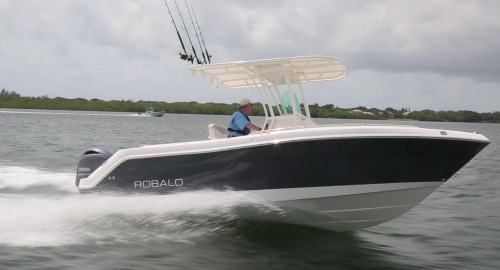
Major Features
General--
- • Bolsters all around the gunwales of the boat
- • Fold-out transom seat standard with an optional full-width one
- • LED courtesy lights in both blue and white
- • Raw water washdown
- • Dual battery switch
- • Premium sound system includes 4 speakers, AM/FM radio, CD player, remote, MP3 plug, Sirius tuner and antenna
- • 10-Year Hull Warranty
- • 2 30-gal. insulated fishboxes, self-draining
- • 15-gallon livewell
- • 4 rod storage in bulwarks
- • 4 ss rod holders
- • Stainless steel toe kicks in cockpit aft
- • 6 vertical rod holders
Fishing Features--
Construction Details
Robalo hulls are hand-laid fiberglass just like most other boats in class. Virtually all builders these days are putting in a skin coat of vinylester resin below the waterline to prevent blistering. All builders put in stringers. With the advent of new, quick-curing polyurethane marine sealants, such as 3M's 5200, builders are now able to chemically bond hulls to decks easily without fiberglassing the two parts together. This method is as strong as a glass bond but is flexible and it is by far less costly -- and far easier -- to install.
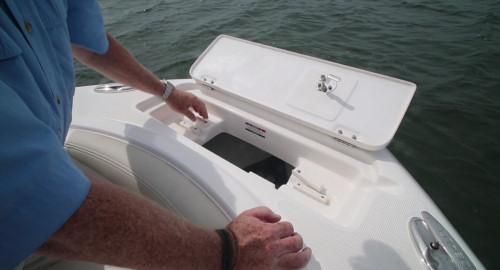
Generally, what sets many boats apart these days are other details of construction. One or two of these details may not be so important, but taken together they very much define the construction of a boat these days. Here are a few of the construction details on the Robalo R222 that we noted--
- • All hatches are RTM (resin transfer molded) which means they are finished on both sides
- • Direct component wiring with buss bars and waterproof ring terminals
- • 4-bolt SS cleats with backing plates, (instead of two bolts and washers)
- • Cast bronze seawater strainer (instead of plastic)
- • Poured composite transom coring, (i.e. no wood)
- • Kevlar reinforced keel for puncture resistance and lighter weight
- • Anchor scuff ss plate on stem to protect the gel coat
Bow
The bow has a good-sized casting platform on top of the forward seating. Seat cushions are standard, and bolsters serve as seat backs. Fish boxes/storage is under the seats as is normal. Forward there is an anchor locker with indents for an 8-lb. Danforth. Cleats are port and starboard; pop-up cleats are optional.
Just forward of the console seat is a hatch in the sole which has space for a 5-gallon bucket.
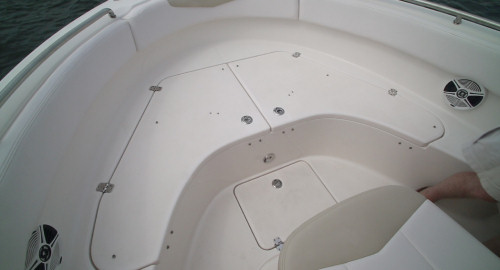
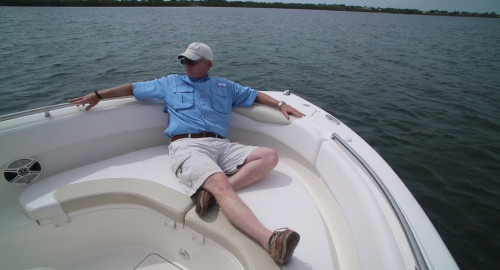
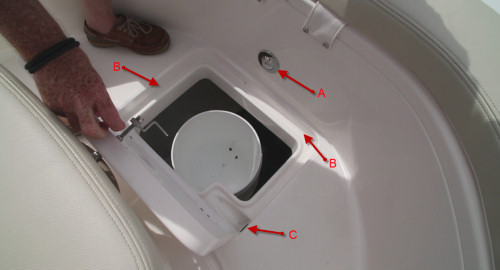
Good Head Access.
The in-console head is accessed from the front by swinging the console seat to port. This is a huge improvement over the standard CC head access hatch which is typically on the port or starboard side of the console. These hatches have always been problematical on center console boats, particularly ones of this size which are limited to an 8'6" (2.59 m) beam.
The entry to the compartment is far wider than on a conventional design and the top is open making it easier for a tall person to enter. Headroom inside is 5'5" (1.65 m). The Porta-Potti is standard equipment and obviously there is plenty of sitting headroom. We like this arrangement, something that heretofore we have only seen in custom-built and premium center consoles.
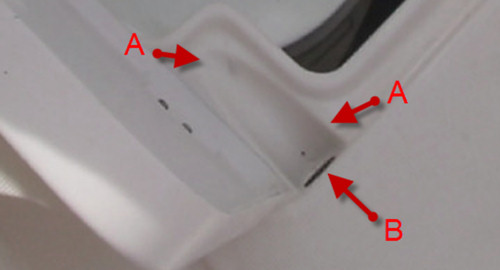
No Monkey Fur.
There is a molded overhead fiberglass lining for the inside of the console. This hides the wiring for the instrument panel at the helm. The interior is not completely lined, but the inside is smooth and clean and it looks a lot better than carpet or monkey fur which we sometimes see in price-point boats.
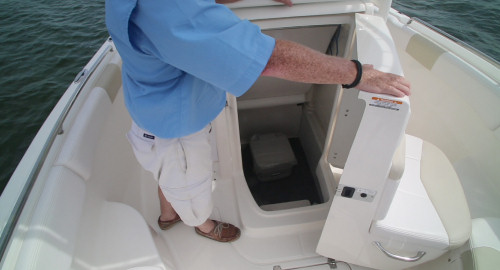
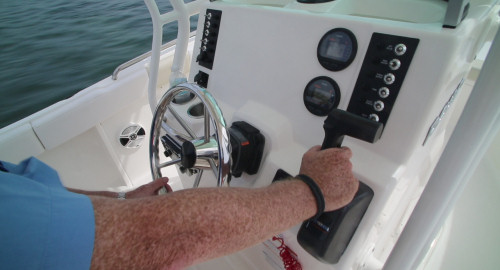
The Helm
The Console.
The helm console is pretty standard but has a few new wrinkles of its own. First, because the head compartment below is fore-and-aft instead of athwartships, the console can be narrower allowing more room for passage on the side decks. Second, there are two molded-in pans on the top of the console to place cell phones and other items. The switches are stainless steel which, unlike plastic, are not susceptible to U.V. damage.
The standard compass is centered on the hub of the wheel as it should be and is a light, high-speed model.
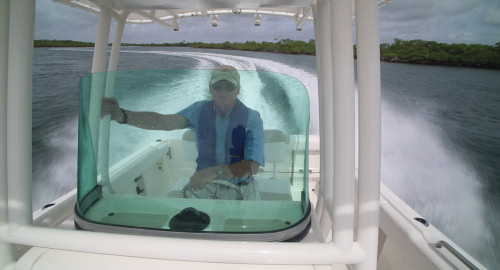
Windshield.
The windscreen is acrylic which is tinted green and set solidly in an aluminum base mounted to the top of the console. Most people would prefer to have a glass windshield, put remember this is a price-point boat and this is one of the places where Robalo has chosen to compromise with a less expensive solution.
Throttle Design.
The throttle is on an oblique angle that is much more vertical than horizontal, a design we are not thrilled with, as regular readers know. Good human ergonomics requires that the skipper's forearm be horizontal for precise throttle adjustments. Virtually all builders install the throttle this way on center consoles, but we wait for the day when someone figures out a way to do it better. (Why not a throttle plunger such as the ones used on small private aircraft? Forward and reverse could be selected with a small lever as on a car. )
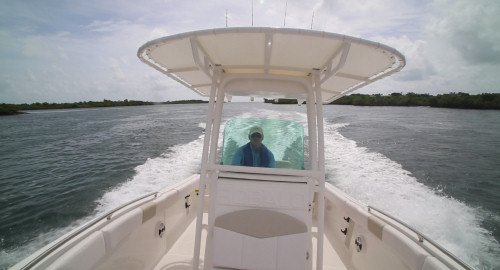
T-Top.
The aluminum T-top with canvas seen in the pictures on this page is an $5,119 option which we recommend. White powder coating is optional ($5,744) and again we would recommend it. There is a compartment built into the overhead of the T-top for electronics.
We like canvas T-tops compared to fiberglass ones because they are lighter and thereby lower the boat's CG lower, and reduce the rolling moment slightly. They are also less expensive than fiberglass.
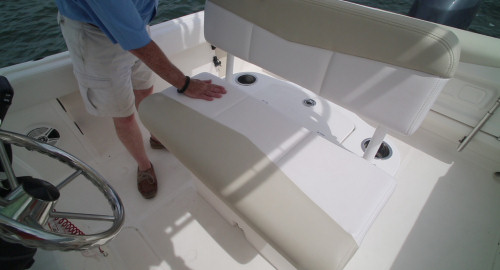
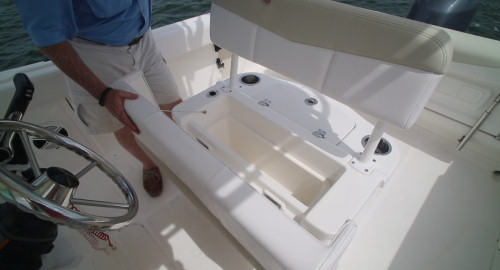
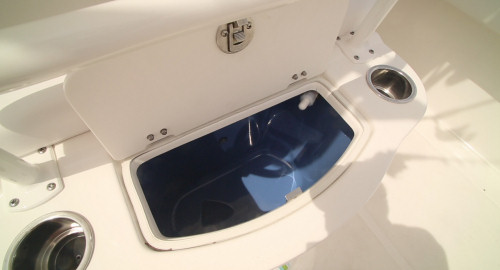
Leaning Post.
The leaning post is standard and has a seat of hinges under the helm seat which allow it to be lifted up and swung forward and out of the way. Inside is a large bin that can handle tackle boxes or most any thing else. The console has a molded foot rest that is designed to work with this seat. Abaft the seat back is the 15-gallon live well which is state-of-the-art. It is blue with rounded corners, LED lights and all of the aeration and pumps that it needs.
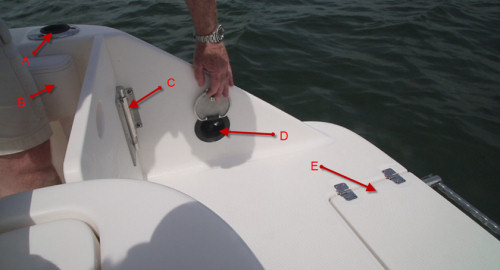
Stern
The outboard well has been designed for more than just holding the outboard in the up position. The raw water bib is there as well as the fuel fill. If a little fuel slops over, it can easily be wiped up in the well. There are also two plastic hatches there to get to the bilge.
Watersports.
The transom door is on the starboard side leading to the three-step boarding ladder which is tucked under a fiberglass lid. The platform there is fairly large for this size boat, so we can see taking the kids out for a little watersports towing now and then. A stainless steel tow frame is available for $585. A freshwater washdown sprayer is located in the stern starboard quarter.
The Transom Door.
Astute regular readers of BoatTEST.com may have noticed that there is a difference of opinion as to whether transom doors should open out or in. Capt Steve prefers to have them open in, so if someone falls on it and the latch breaks, they don't fall out.
Others on our staff, however, disagree in the case of center console boats designed to go offshore. Here, they feel there is a far greater imperative, and that is if in sloppy conditions a large wave should cascade into the boat, it must be dewatered immediately. The fastest way to do that is through the transom door -- opened out, not in.
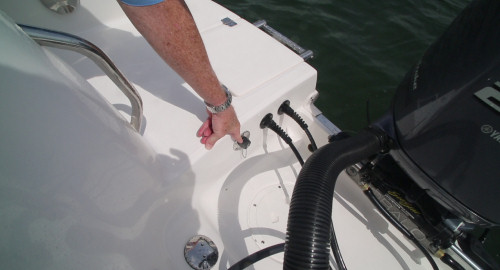
Good Drain Design.
Clearly the folks at Robalo have given this subject a lot of thought. We say that because of the attention that has been paid to the design of the scuppers of the self-bailing cockpit in the R222. Not only are they relatively large, but they are on the vertical in the transom bulwark, not horizontal in the cockpit sole. Further, they are open and do not have a metal plate over them with a dozen or so small holes punched in it.
Where Boats Sink.
Unfortunately, we see these drain plates in center consoles all of the time. This design lets less than half of the water through as would drain out otherwise in the same time period. Most boats that sink do it at the dock or on a mooring. A typical reason for this is that in boats that are not self-bailing rainwater exhausts the battery at some point and the automatic bilge pump stops working. In self-bailing cockpits, if they sink from rain water it is because leaves, rags left aboard, or other debris has washed over those little holes in the drain plate and clogged them up.
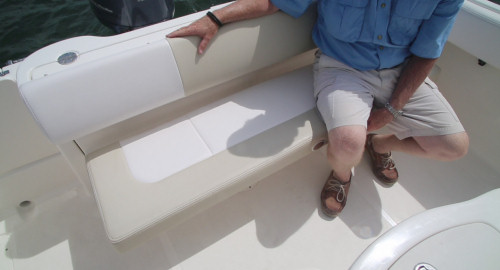
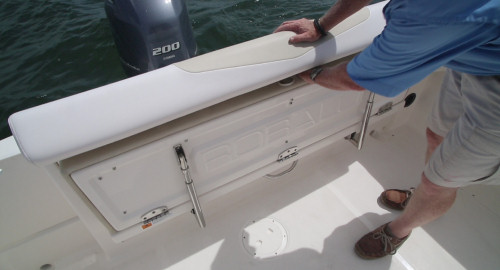
Performance
The Robalo R222 has a LOA of 21'6", a beam of 8'6" (2.59m)' and a draft of 34". With an empty weight of 3,200 lbs, 45 gals of fuel and two people onboard, we had a test weight of approximately 3,890 lbs.
With a Yamaha F200 XP turning a 14 1/2 x 15P Reliance prop we reached a top speed at 5800 RPM of 41 MPH. At that speed we were burning a total of 19.45 GPH giving us a range of 171 miles while still maintaining a 10% reserve.
Best cruise came in at 4000 RPM and 26 MPH. That speed reduced the fuel burn to only 7.6 GPH which translates to a range of 277 miles and an endurance of 10 hrs 42 min.
We reached planing speed in 3.3 seconds, accelerated to 20 mph in 6.5 seconds, and continued accelerating through 30 mph in 10.1 seconds.
Handling
With her high freeboard the 222 is perfectly at home in offshore conditions. She handled the chop that we took on the way to the testing grounds like she was made to be there, which coincidentally... She was. There was no pounding through the waves but more of a clean slice through, with spray thrown well to the sides and kept low for a dry ride. She tracks straight and true through following seas with no tendency to stuff the bow or get pushed off course. In the beam there was minimal rolling but well within the realm of expected behavior, all adding up to a 7-8 on our quality of ride scale.
Power and Price
As noted the standard R222 comes with a Yamaha F150XA (and it has a stainless steel prop) with mechanical linkage and has an MSRP of $40,795. Robalo makes available an F200XB for an MSRP of $43,885 and at F250XA for $47,795. Both of these upgrades have mechanical linkage.
We urge consumers to closely study our "Test Results" (click on the tab at the top of the page) in order to select the right amount of power for the intended application. Remember, all small boats are weight sensitive.
Observations
We would say that the strong points of this boat are its superb handling characteristics, its sea-keeping abilities, its utility, its abundant list of standard features, and its price.

